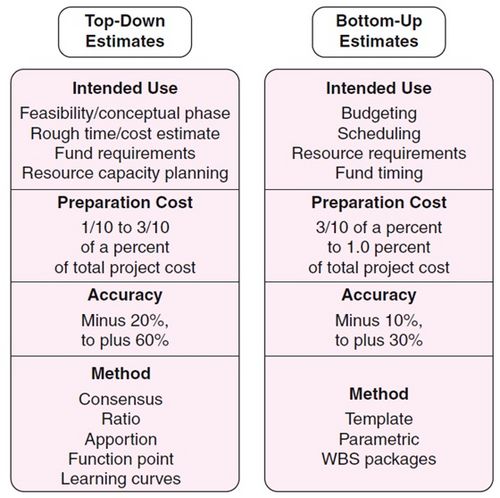Estimations: Basic Techniques
From apppm
Contents |
Estimation Techniques
Historical data
Parametric estimating
- Based on parameters, e.g. square meters, tons of steal, etc. This can vary in levels of detail, from 1 parameter to several
- Projects are rarely totally unique, often repetition of activities at lower levels of WBS
- Break down project into units that can be readily estimated based on considerable experience of a particular type of project
- Can be used at different levels of the product breakdown
Expert judgement
People are asked to make rough estimates, but the estimate becomes the target time
- One or more experts in the application area use their experience to predict costs or time. Process iterates until some consensus is reached. (Also called Delphi studies)
- Advantages: Relatively cheap estimation method. Can be accurate if experts have direct experience of similar projects
- Disadvantages: Very inaccurate if there are no experts!
Analogy or As… but…s
- Experience of similar projects
- Use previous cost as base line (assuming validity) and proportion up or down
- The time or cost of an project is computed by comparing the project to a similar project in the same application domain
- Advantages: May be accurate if project data available and people/tools the same
- Disadvantages: Impossible if no comparable project has been tackled. Needs systematically maintained cost/time database
- Note: make sure you use the real cost and not the budget of your reference project
Forecasts
- A ‘best guess’ under uncertainty (e.g. exchange rates)
- Use parametricsor proxies
- Differentiate between fixed (firm/known) and variable costs (fluctuate, estimate)
- Provide series of estimates to see impact on budget
- Factor in element for risk
Synthetic estimating
- Based on practices of work measurement
- If large number of repetitive actions, work rate can be analysed to provide generic actions, timings and costs
- Deconstruct new activities into similar actions and add timings
Using learning curve effects
- Often repetitive elements at lowest level of WBS
- Time taken for a task if repeated will decrease as the person becomes familiar with the method
- Subsequent improvement is speed becomes smaller over time
"missing formulas"
Wishful thinking
- Optimism bias –over-optimistic on how much can be achieved and how little it will cost
- Politics –large figures likely to be unacceptable, the objective is placed above costs
- Improper use of estimates –ball park figures become official without checking or further development
- Failure to be systematic about planning –complacency, certainty will not have to do work, vagueness, unqualified estimate to ‘get the request off the desk’
- The best techniques are still only estimates
- Errors at this stage can be multiplied many times
Things to consider
- Rapid, rough and right (roughly right over precisely wrong) –detail over time
- Three point estimate, qualitative understanding, thinking of alternatives
- The best techniques are still only estimates
- One size does not fit all! Level of precision depends on the project
Bottom Up and Top Down Estimation
Any of these approaches may be used top-down or bottom-up.
Top-Down
- Start at the system level and assess the overall system functionality and how this is delivered through sub-systems.
- Usable without knowledge of the system architecture and the components that might be part of the system.
- Takes into account costs such as integration, configuration management and documentation.
- Can underestimate the cost of solving difficult low-level technical problems.
Bottom-Up
- Start at the component level and estimate the effort required for each component. Add these efforts to reach a final estimate.
- Usable when the architecture of the system is known and components identified.
- This can be an accurate method if the system has been designed in detail.
- It may underestimate the costs of system level activities such as integration and documentation.
Top-Down Estimates
- Are usually are derived from someone who uses experience and/or information to determine the project duration and total cost.
- Are made by top managers who have little knowledge of the processes used to complete the project.
Bottom-Up Approach
- Can serve as a check on cost elements in the WBS by rolling up the work packages and associated cost accounts to major deliverables at the work package level.
